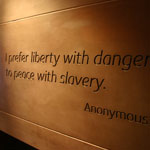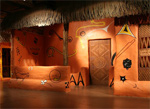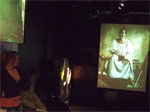Interview with Sara Hilton
Sara Hilton, now Regional Manager of the Heritage Lottery Fund was the Director of Projects at the National Museums of Liverpool during the construction of the International Slavery Museum. In this interview she describes the narrative journey through the ISM and the processes of getting the design right for the project. Interviewing Sara Hilton is Helen Weinstein, they are identified as SH and HW respectively.
HW: So can you just talk me through the journey of the International Slavery Museum, the narrative journey you want the visitor to have?
SH: The challenge for us or one of the many challenges for us is that we had to get the narrative to work for the first three years from 2007 to 2010, as we're working with a narrative which has to work with our visitors entering our museum within an existing museum. The International Slavery Museum is located on the third floor of the Merseyside Maritime Museum and visitors enter the museum from the lifts of the Maritime Museum. So for that narrative to come to life whether visitors are coming up the lifts or up the staircase within the Maritime Museum they are entering a very, very new space.

Detail taken from the Freedom Wall, International Slavery Museum
We wanted the design to immediately make you feel that you're in a very, very different space. We wanted to make a mark that this was an international museum, so the use of the colour grey, the almost iconic structures set the tone for a very, very different aesthetic to the rest of the Maritime Museum. It sets up the introduction that we want to remember that we’re not just having a historic perspective; we want to remember the enslaved Africans and what they went through. That’s achieved through the voices immediately within the Freedom Wall where you've got the quotes and the voice of people who have either endured slavery, contemporary slavery or people who comment on contemporary slavery and historic slavery. That human voice achieved through the written quotes and through the spoken word looks across at the Igbo compound, at the culture of Africa and where the enslaved Africans were wrenched from. It was important to place objects here for display, so it wasn't just a hi-tech exhibition. We went from the freedom wall where you’ve got all that audio-visual technology into Africa where you've got a lot of our African collections and the reconstruction of the Igbo compound.

The reconstructed Igbo village, International Slavery Museum
What is important within that was that we use actual African carvings, the actual paintings, so we used African craftsmen and artists to make those panels. All of these have stories within themselves in terms of the challenges of delivery and it would have been very easy to deliver it in a different way. We looked at those options for the Igbo compound, but it was very important to us that we tried to get authenticity into those displays. Yes it is a reconstruction but it is authentic as we can get it in terms of the type of painting, the colours, and the decorations of those panels.
HW: And what do you want the visitor to take away from that, what’s the main thing you want to say?
SH: It’s a space to be used, to think about the culture that these people were taken from. That they had lives, that they had homes, that they had traditions, many of which were more complex than in the western world. This space says that they weren't nameless people, that they had a history and that they had a culture.
HW: Could we talk a little about the Middle Gallery now?

The Middle Passage Gallery, International Slavery Museum
SH: The Middle Gallery with the Middle Passage audiovisual at the heart of it is interesting because when we developed it the central audiovisual was seen very much as the core experience. Whilst we intended it to be central to the visitor experience we didn't want to force the circulation around the museum so we looked at a lot of different circulation routes through that middle gallery space. We have deliberately offset the circulation, so not everybody coming through from the African area automatically enters the Middle Passage. We looked at a lot of different variable for that, but we felt it was important that people went in there by choice. We wanted it central but we didn’t want to force people through. We wanted the look and feel of The Middle Gallery to be very different, so it is a darker space, its darker partly also because of the artefacts that we’ve got and the care of those in terms of light levels. Whilst it is functional, because we had to drop the light levels, we wanted it to be a very different flavour. The darkness is not only with the Middle Passage audiovisual itself but also in the Daily Life section, which is incredibly important for the museum as a whole.

International Slavery Museum: photograph of the Daily Life section with video installation
Larger image (33KB)
Interestingly, the daily life audiovisual with the story-teller, talking about life on the plantation, and the Igbo compound started life as exactly the same thing. Both of them were meant to be a reconstruction of a dwelling, the Igbo compound was meant to be reconstruction of an African dwelling, and the Daily Life area was meant to be reconstruction of a slave hut. What happened in the design development process was that we started to think about different ways of reconstructions. In a way it’s deconstructing a space. We started to think about how you evoke a space, a lifestyle, a story, the people, without necessarily having to go through the traditional reconstruction. That went through an incredible creative development process. It started to be a much more creative look at evoking life on a plantation and then the creative process continued as we took on our audiovisual producers as they themselves brought in their own creative take. They brought in the style of the graphics that we use. The graphic designers working as part of the exhibition design team were receptive to this, they had an original take on how the graphics would look but they set that to one side and took on board the audiovisual producers graphics. I think what we've come out with is a far more evocative space and a thought-provoking space than we might have had.
HW: So what's the main message in the narrative that you want the visitor to take from The Middle Gallery?
SH: What terrible, unbelievable inhumanity we put these people through and how what a completely twisted view of life view of society that we had at that time in terms of thinking of people as human cargo. But through that darkness there was the strength and resilience of the people. I hope that we get that across through some of the voices that we have there.
HW: And could you talk me through the last section, The Legacy Section.
SH: The Legacy is our lighter space, where we see the story of the strength and the resilience of the people. It actually starts in The Middle Gallery. We deliberately start that fight for freedom within The Middle Gallery and continue it through the legacy area. The different outcomes that came out of slavery, the legacy of racism, discrimination, global inequality, all of those things have their roots in slavery. We then also look at the cultural transformation that the African Diaspora has achieved the positive worldwide effects of individuals of African heritage. This should be a dynamic space; it should be a living and breathing space. We worked again with the design team and we worked with the community groups to deliver that content.

